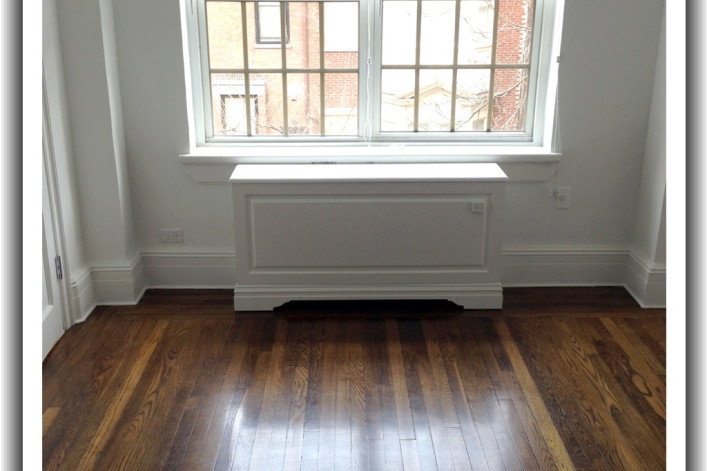Prewar apartment feeling like a sweatbox? One Hamilton Heights building explores its heating options

Could this "cozy" radiator cover be an answer to uneven heating in prewars?
Photo: Radiator Labs
What's chilly outside, hot inside, and has open windows way before spring has finally sprung? If you live in a New York City prewar building, you may already know the answer.
Living in a prewar building with original features is one of the best things about NYC. The apartments in our co-op, for instance, all have high ceilings with crown molding and thick plaster walls and wood doors, all of which give us a sense of living in a solid, permanent structure that has character and history.
But the prewar steam heating that comes with this place? That's another story. Actually, it's the bane of our existence, as it is for so many New Yorkers.
So, at the beginning of this year, my building decided it was time to invest in some improvements. While oil prices vary, being more affordable some years than others, residents have long wanted to curb energy waste and improve heat efficiency in an effort to be more eco-friendly and economical. Plus, we've also had some long-standing complaints of overheating or lack of heat from several shareholders, which had to be addressed. Simply put, we needed to overhaul the heating system in our building, which turned 100 years old last year, or else it wouldn't make it to its next centennial.
How heating works—and doesn't
For the most part, steam heat systems are a good way to heat a room: Water is heated in a boiler in the basement, and the steam from this rises through pipes that divert it to individual radiator units in apartments. Whether a one-pipe or two-pipe system, the set-up is essentially the same in larger multi-family residential buildings as it is in brownstones.
In theory, this should all work just fine. However, the system has to be balanced to work efficiently, and in our old residential buildings, the system rarely is balanced. (Very simply put, a balanced system is one where all radiators receive the correct amount of steam to produce heat. In an improperly balanced system, some radiators get all the steam, while others barely any. Excessive rattling or leaking valves on radiators may be symptoms of imbalance in a heating system.)
As we've reported before, thermostatic radiator valves (TRVs) is one possible solution to the problem of overheating, particularly if you're a renter. TRVs can be installed onto existing radiators to control the amount of steam entering your radiator, which then directs the amount of heat a radiator puts out; TRVs typically have five or six heat-level settings. TRVs can provide a good solution for heat regulation in overheated apartments, and it's especially friendly to renters because of the minimal financial investment it presents.
Our building decided to first try the TRV route, installing one on a radiator in one apartment. It cost less than $50, and the super was able to install it without any problems.
The best time to do any work on your radiators is while they are not in use. We decided to look at some options this winter so that work could hopefully commence and be completed during the spring and summer, just in time for the next cold season. So, we thought installing the TRVs around January for testing was perfect timing. However, we immediately encountered a problem: The radiator was not receiving sufficient heat for the TRVs to be tested. There was no heat output to regulate in the first place. Whatever underlying problem(s) there are in our imbalanced heating system was not addressed by the TRV.
In addition, any such installation immediately throws up some warnings: Though relatively easy to install for a handy super (ours is), different supers have different skill levels and it's hard to predict how well future repairs will be handled if staff changes. And TRVs will always require some maintenance and even repair or replacement because such is the case with anything that continually comes in contact with heat and moisture. Even from just one installation, it was easy to see what a huge job it would be to install TRVs throughout the entire building. Hiring outside plumbers to do the work will increase our expense exponentially. Also, valves that are designed to be operated by residents are often fated to be damaged in some way.
Still, TRVs seem to be, at least in terms of upfront cost and effort, a cheap and easy solution, if we manage to get our system balanced first.
Another option may give cover
Enter the Cozy, a product that its maker, Brooklyn Navy Yard-based Radiator Labs, believes could be a building-wide solution that doesn't require a more-often-than-not cost-prohibitive total overhaul of building's heating system. The Cozy is an insulated radiator cover equipped with smart sensors and a fan that actively pushes heat to a room when required.
"Most of the buildings in older cities, like New York, were built before World War II. Back then, we didn’t have reliable water pumps or fans and, as a result, the only heating technology available for larger buildings was steam heat," explains Adam Wolf, sales manager at Radiator Labs. "In that era, plumbers and pipe-fitters had rules of thumb for sizing piping and radiators appropriately to distribute the amount of heat needed to evenly heat a building." But since then, he adds, many things have changed about our buildings, one of the most impactful being the advent and near-universal-retrofit of double-pane insulating windows. These differences have contributed to a significant imbalance in almost all of our steam-heated buildings today which, since landlords are required by law to provide minimum heat to residents (68 degrees during the day, 55 degrees at night), results in the vast overheating that so many of us are familiar with."
(According to heating expert and author of The Radiator Handbook, Dan Holohan, another factor causing our current overheating issues may be that in the early part of the 20th century, radiators were manufactured to be so large and produce so much heat that residents would not freeze when they opened their windows —something they were advised to do to ward of airborne diseases like Spanish influenza—hence the cranked-up warmth.)
As a reinforced, metal radiator cover, Cozy is a sturdy piece of "furniture" on which plants and cats happily may sit. It also requires no connection with pipes or plumbing and is custom-built for each radiator unit for a perfect fit. However, in order for the entire heating system to work optimally, at least 75 percent of the whole building will have to participate. Why? "In a traditionally hot room that has reached a comfortable temperature, The Cozy would ‘close’ and contain heat, which drastically reduces the amount of steam that particular radiator would condense, or 'use'. This uncondensed steam (which would have previously just been overheating an apartment) ends up flowing elsewhere in the steam system, toward any rooms [in the building] that still have an 'open Cozy' (im other words, the cooler rooms). The end result is more steam for colder rooms, and a more efficient use of energy," says Wolf. "If you install a Cozy on one radiator in a cold room, we would not be able to increase that room’s temperature. However, when you install Cozys in [at least] 75 percent of a building, our system is able to ‘push’ steam from hot rooms more efficiently to cold rooms," Wolf explains.
Not a one-size-fits-all solution
But the Cozy isn't right for all buildings. Radiator Labs conducts a feasibility study in each building considering an installation to see if 75 percent of the apartment and radiator set-ups can (and the residents are willing to) accommodate the Cozy. In building where there aren't many complaints of overheating, the product will likely not be able to generate savings enough to offset the investment. And the investment is quite significant.
Plus, each radiator cover will cost $500. In our building’s case, that’s multiplied by three to four radiators per apartment, of which there are sixty in the building. Even if we only need this high-tech radiator cover on 75 percent of all radiators in the whole building, this would be a huge investment.
If our building is a good candidate for the Cozy, our building will have to weigh that expense against various factors such as current funds, potential savings, and the residents’ comfort levels. Radiator Labs is currently conducting a feasibility study in our building in which they are measuring each radiator and noting their placement in the apartment.
Another caveat to the installation of the Cozy is that building participation can sometimes be unpredictable. In my building, we put up notices informing residents that we needed access to their radiators. Via a sign-up sheet, we asked them to choose a time during one of three days that they could let Radiator Labs technicians into their apartments to measure and assess the space around their radiators. Only about half of residents responded. If, after finally completing this “feasibility study”, it is determined that the Cozy is a viable option for our co-op, we will still have to convince residents to allow the Cozy to be installed in their homes. While the sleek, simple look of this white, metal radiator cover may work for some, it will almost certainly not be liked by all. In that, a small, unobtrusive TRV has a huge advantage: it’s practically invisible—especially to those who already have conventional wooden covers over their radiators.
While Thermostatic Radiator Valves have the advantage of being cheaper (in most cases it would be an upgrade of around $50 per radiator, plus labor costs) and qucker and easier to install, after installation, they are left to the mercies of residents. They may get damaged and begin to malfunction. In NYC especially, where apartments turn over often and repainted between tenants, they are too often just covered over with coats of new paint.
As of now, Radiator Labs is still working to complete their feasibility study in our building. We all still need to communicate with each other as neighbors, and work to see if everybody can grant access to their apartments to conduct the study. If we get the requisite amount of participation, the board will decide if this high-tech box is what our prewar builiding needs for the future. Let's hope we come to some consensus by next winter.
You Might Also Like
























